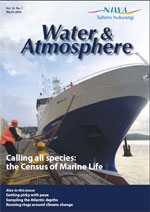PDF of this article (64 KB)

One of NIWA’s aims with this magazine is to contribute to science education in New Zealand. To this end we distribute Water & Atmosphere without charge to New Zealand high schools. Articles are assigned ‘Curriculum Connections’ to indicate which of the NZ NCEA Achievement or Unit Standards they can complement as a classroom resource. These links are assigned by Royal Society of New Zealand Teacher Fellows who are working during the year with NIWA scientists.
The magazine and the Curriculum Connections are also available online at www.niwa.co.nz/pubs/wa/ There you’ll find an archive of back issues beginning with September 2000 (vol. 8, no. 3). All online articles include a pdf of the printed version and the articles are indexed via the website’s search engine. The Curriculum Connections are compiled at www.niwa.co.nz/pubs/wa/resources/
Curriculum connections for this issue
| Pages | Article | Relevant NCEA Achievement Standards (AS) and Unit Standards (US) | Brief summary |
|---|---|---|---|
| 10–11 | Bubbles on the Hikurangi Margin: the New Zealand cold vents project | Biology Level 1 90162 Science Level 1 US6349, AS90187, Level 2 AS90771 | Methane rising from cold seeps in the seabed along the NZ coast supports distinctive biological communities. |
| 12–13 | No ordinary stock-take: Census of Marine Life | Biology Level 1 AS90162 | NZ researchers are participating in a suite of programmes that contribute to the grand and global task of identifying all marine life. |
| 14–15 | Sampling the Atlantic depths | Biology Level 1 AS90162, Science Level 1 US6349, AS90187, Level 2 AS90771 | Plankton specialists hitched a ride on a ship bound for Antarctica in order to take deepwater samples off the coast of Africa. |
| 16–17 |
Hidden potential for harmful algal blooms in our ports and harbours |
Biology Level 3 AS90714 Geography Level 2 US5092 Science Level 3 US6365 |
Because of a resting phase in their life cycle, dinoflagellates – both toxic and nontoxic – can lie unnoticed in sediments until the right conditions trigger regrowth. |
| 18-19 | Biology Level 1 AS90164, US6294, Level 2 AS90460, AS90461 Science Level 3 US21613 | Growing commercial interest has prompted a survey to determine the sustainability of the surf clam resource. | |
| 20-21 | Getting picky with paua: selective breeding to improve productivity | Aquaculture Level 2 US17254 Biology Level 1 US6299, Level 2 AS90459, US8929 Economics Level 1 AS90196 Geography Level 1 AS90204, US5085 | NIWA research is helping marine farmers improve their productivity by developing superior paua broodstock with known characteristics and predictable offspring. |
| 22–23 | “Detergent of the atmosphere” | Chemistry Level 3 US6340 Science Level 3 US21613, US6355 | OH, the hydroxyl radical, is the most important oxidant in the troposphere,cleansing the atmosphere through a series of chemical reactions. |
| 24–25 | Biology Level 2 AS90769 Earth Science Level 2 US6362 | Dendrochronologists are using tree-ring data to extend climate records into the past. |
